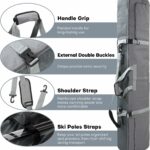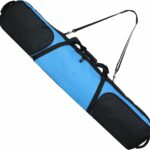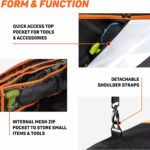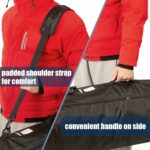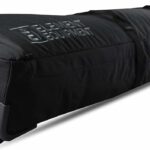So, you’re planning your next snowboarding adventure, and you’re pondering over which size snowboard bag you should opt for. The article we’re about to discuss deals with just that. It provides a comprehensive guide on picking the perfect snowboard bag, catering to your unique needs and snowboarding equipment. Customizing your choice, considering factors like board size, gear, and travel requirements can all be a bit overwhelming, but no worries because we’re about to break it all down for you, making it significantly easier and manageable. So let’s jump right into it.
Understanding the basics of snowboard bag sizes
When it comes to snowboarding, transportation of your gear can be just as important as the gear itself. In this discussion, we dive into the details of snowboard bag sizes to help you make an informed decision when purchasing one.
Standard bag sizes and their features
Snowboard bags come in a range of sizes to cater to different needs. While some are designed to hold just a snowboard, others provide enough room for additional gear. Features vary by size; smaller bags tend to be more lightweight and easy to carry, while larger ones offer more storage space and additional compartments for gear.
Measurement of the bag – how it differs from the snowboard length
The sizing of your snowboard bag should be based on the length of your snowboard. However, it’s not an exact science; the bag size does not match the snowboard length as an inch-to-inch ratio. This is because the snowboard has to fit inside the bag with room to spare for other equipment and padding to protect your board during transit.
Typical bag sizes and how they accommodate different tools
Typically, snowboard bag sizes range from 140cm to 175cm. Smaller bags generally fit a single snowboard and perhaps a few small essentials, like gloves or goggles. A larger bag, on the other hand, can accommodate multiple boards, boots, helmets, and clothing, providing you with an all-in-one solution for transporting your gear.
Factors influencing the choice of the snowboard bag size
The size of your snowboard bag ultimately depends on a variety of factors, such as your snowboard length, extra gear, travel plans, and material considerations.
Length of your snowboard
First and foremost, the length of your snowboard determines the minimum size of your bag. The snowboard must comfortably fit within the bag without any pressure on the edges or tips of the board.
Extra gear and clothing
If you’re planning to bring additional gear such as boots, helmets, and clothing, you’ll need to factor in extra space. A bag that offers extra compartments or pockets can be handy for storing these items separately.
Travel plans and requirements
For those often traveling to snowboard, a bag with wheels can be more comfortable to transport. Additionally, consider the airlines’ baggage policy, since some may have strict restrictions on bag sizes.
Durability and material considerations
The bag’s durability should also be considered. You will need a strong, heavy-duty bag that can withstand rough handling, especially during check-in procedures at airports.
Essential features of snowboard bags
Not all snowboard bags are created equal. There are several key features to look out for that can make transporting your gear easier and more efficient.
Padding for protection
A well-padded bag can protect your snowboard from bumps and scrapes during transit. This is particularly important if you’re traveling a long distance or you’ll be handing your bag to airport staff.
Wheel or no wheel – Ease of transporting
Wheels can make a significant difference when it comes to transporting your gear, especially if you’ve got a long way to lug it. A wheeled bag can save you from carrying heavy gear and make your travel much more comfortable.
Compartments and additional storage potential
Depending on how much extra gear you’re bringing, additional compartments can be incredibly beneficial. They help keep your kit organized, so you can quickly and easily locate your items.
Waterproofing factor for protection against moisture
A snowboard bag has to defend against moisture, too. Snow melt can seep into a bag, potentially damaging the board or other equipment. Waterproof or water-resistant materials can provide an extra layer of protection.
Benefits of a bigger bag
Perhaps you’re questioning whether to go for a larger snowboard bag or not. Let’s weigh up the benefits.
More storage options
With a bigger bag, you’ll enjoy more space for your snowboard and extra gear. You could even fit another snowboard in if you wish. Plus, there’s usually room for non-snowboarding essentials as well.
Accommodation for multiple boards
Whether you’re an enthusiast with several boards or a family snowboarder, a larger bag means you can perhaps carry more than one board.
Extra padding and protection
Larger bags often come with additional padding, providing extra protection for your snowboard during transit.
Room for growth and additional gear
A larger bag provides room for growth. If you decide to upgrade your snowboard or purchase additional gear down the line, you’ll already have a bag that can accommodate it.
Drawbacks of a bigger bag
However, a larger snowboard bag isn’t always the best choice. Let’s talk about some potential drawbacks.
Higher cost
Larger bags usually come with a higher price tag. You would need to decide whether the additional space, compartments, or extra protection are worth the increased cost.
Difficulty in carrying
A larger bag might be more challenging to carry, especially when fully loaded. This could be an essential aspect to consider if you’ll be traveling frequently or over long distances.
Takes up more storage space
While a bigger bag is more spacious, it’ll also take up more room when it’s not in use. It might be worth thinking about where you plan to store the bag.
Potential over-packing
With a larger bag, there’s always the temptation to pack more than necessary, leading to an overfilled, bulky bag that can be hard to move around.
Benefits of a smaller snowboard bag
If you’re a minimalist, or don’t frequently snowboard, a smaller bag may be appropriate. Here are some of the perks of going small.
Lightweight and easy to carry
Being lightweight is perhaps the primary advantage of a small snowboard bag – they’re far easier to carry around. This could be particularly beneficial if you’re traveling by foot or public transportation.
Cheaper in cost
Smaller bags tend to be more economical, a definite advantage if you’re on a budget or don’t plan to use it frequently.
Easy to store when not in use
You’ll have less trouble finding a spot to keep it when it’s not being used, thanks to its compact size.
Ideal for short trips and less gear
If you’re planning a short trip or don’t have much gear to bring along, a smaller bag can fit your needs without any space wasted.
Drawbacks of a smaller snowboard bag
On the downside, a smaller bag does come with some constraints.
Limited storage space
There’s not much room for extras apart from your snowboard. This could be inconvenient if you have a lot of gear or if you’re planning longer trips.
Risk of damage due to less padding
Smaller bags often have less padding, which means your snowboard may be more vulnerable to damage during transit.
May not accommodate longer boards
If you have a longer snowboard, it may not fit into smaller bags, limiting your options.
Requires careful packing
With limited space, you’ll need to be extra strategic when packing your gear, which may take some extra time and thought.
Which bag size is suitable for traveling?
When deciding on a snowboard bag for traveling, there are several factors to consider.
Bag size restrictions in airlines
Just like any luggage, snowboard bags must adhere to the size restrictions imposed by airlines. Oversized luggage may be subject to additional fees, so it’s important to check with your airline in advance.
Consideration of bag weight for travel
The weight of your bag can also affect your travel experience. Heavier bags can be more difficult to maneuver and may incur additional fees at the airline’s check-in counter.
Ease of transportation – wheels or no wheels
Wheeled bags offer a tremendous advantage for travel, making it easier to move your gear around airports or transit points.
Padded bags versus non-padded bags for travel
A padded bag can provide greater protection for your snowboard, especially during long-haul flights. However, they can be bulkier and heavier than non-padded bags.
Maintenance and care for your snowboard bag
Your snowboard bag deserves attention and care to keep it in the best shape possible.
Cleaning guidelines
Check your bag’s label for cleaning instructions. Most bags can be wiped down with a mild soap solution, while others may be machine washable.
Regular inspection for wear and tear
Regularly check your bag for any signs of wear and tear, such as ripped seams or broken zippers. Timely repairs can extend the life of your bag.
Care for zippers and wheels
Apply a zipper lubricant periodically to keep zippers running smoothly. If your bag has wheels, check them for any damage or debris that might impede their movement.
Proper storage when not in use
When your bag isn’t in use, store it in a cool, dry place away from direct sunlight. If possible, keep it in a dust bag for added protection.
Relevant Bag brands to consider
There are many good snowboard bag brands out there, each offering a variety of models and features.
Review of renowned snowboard bag brands
Some renowned brands include Burton, Dakine, and EVOC. They’re well-established in the snowboarding industry and known for their durable, high-quality bags.
Comparison of different models and their features
It’s beneficial to compare different models within your chosen brand to see the varying size options, features, and prices available.
Price range and value for money
Snowboard bags vary significantly in price. While you often get what you pay for in terms of features and durability, it’s essential to assess whether a bag offers good value for your money, especially if you’re on a budget.
Customer reviews and recommendations
Reading online reviews from other customers can provide valuable insights into a bag’s true performance and durability. It’s also an excellent way to compare different brands and models.
In conclusion, the right snowboard bag size depends on your unique needs and circumstances. Whether you require a minimalist design for light travel or a larger bag for regular snowboarding adventures, understanding the factors that influence this decision can help you choose the best snowboard bag for your needs. Happy snowboarding!
- What Snowboard Bindings Should I Get? - January 23, 2024
- What Size Screws For Snowboard Bindings? - January 23, 2024
- How To Snowmobile On Water? - January 23, 2024

